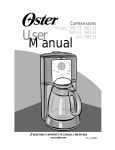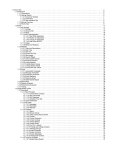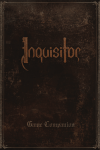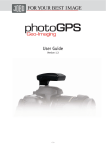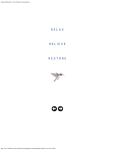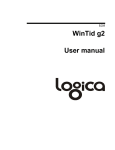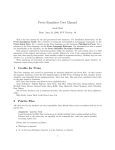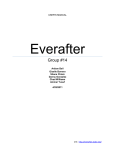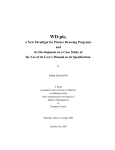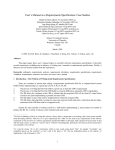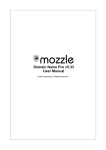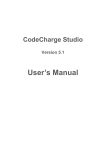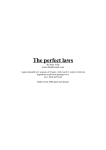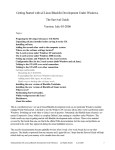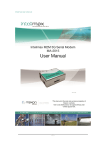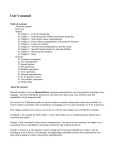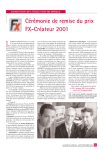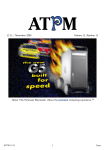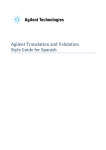Download User`s Manual as a Requirements Specification
Transcript
User’s Manual as
a Requirements
Specification
Daniel M. Berry, 1991, 1998, 2002, and 2003
with help from K. Daudjee, J. Dong,
I. Fainchtein, M.A. Nelson, T. Nelson, &
L. Ou
© 2003 Daniel M. Berry
A Note About This Talk
This talk was first written in 1991, prior to the
community’s identification of the concepts of
scenarios and use cases, as being helpful in
requirements engineering (RE).
It is interesting to see a lot of examples of
these concepts in these slides, but not sonamed.
I have added text in this font in 1998, to
rephrase in the new vocabulary.
Requirements Engineering Manuals as Requirements Pg. 1
Introduction -1
Introduction -2
I have been asked what I believe a good
requirements specification (RS) is.
I believe that the most useful document to
write during requirements engineering is the
user’s manual (UM).
Here is my opinion.
For pedagogic purposes, it is intended to be
slightly controversial.
The “you” in these slides is the requirement
engineer.
When done right and at the right time, it can
serve as a useful elicitation, analysis, and
validation tool, and can even serve as a RS.
Introduction -3
Introduction -4
Please note that I am not discounting the other
requirements documents, including the SRS.
However, I have found the production of the
UM a good focal point in the requirements
engineering process and a good way to get on
to paper at least the kernel of all the
information that goes in the other documents.
They may be required by the customer.
They may give useful information that is not
contained in the UM.
Role of Writing a RS -1
There are a number of reasons that writing a
RS for a computer-based system (CBS) before
implementing it is a good idea.
The process of writing the RS of the CBS is
a good way to learn the CBS’s
requirements.
The process of writing the RS of the CBS
helps to reconcile differences among the
CBS’s stakeholders.
Role of Writing a RS -2
The RS allows the customer of the CBS to
validate that the projected CBS will be what
he or she wants before resources are spent
implementing a possibly incorrect CBS.
The RS makes it clear what must be
implemented to obtain the required CBS.
The RS allows deriving both covering test
cases and expected results that allow
verification that the implementation of the
CBS does what it is supposed to do.
Problems Writing a Good RS -1
Despite clear benefits of writing a RS for a
CBS before implementing it, many projects are
unable to produce the RS, for a variety of
reasons, some technical and some social.
It is difficult to write a good RS, one that
specifies exactly what the CBS is supposed
to do without limiting unnecessarily how to
implement it.
Problems Writing a Good RS -3
Participants in most projects these days
perceive that time spent on writing a RS is
wasted since the requirements will change
anyway and the RS will probably never be
read, even by the implementers.
Problems Writing a Good RS -2
Participants in most projects these days
believe that they do not have the time to do
so, that it is necessary to proceed
immediately, if not before, to coding, in
order to meet the code’s delivery deadline
or to be the first in the market with the
code’s functionality (Never mind how they
know what to implement anyway if there is
no RS).
Writing UM May Be Solution
This talk offers writing a UM for a CBS before
implementing it as a way achieving the writing
of a RS of the CBS before implementing it.
The method both
produces a document that delivers the five
benefits of writing a RS before
implementation and
helps ameliorate or mitigate the three
problems that discourage the production of
a RS before implementation.
Information in a UM -1
Information in a UM -2
An RS for a CBS should
A good UM for a CBS should
describe the CBS’s function and not the
CBS’s implementation,
describe the CBS from the user’s point of
view and not the implementer’s,
describe the CBS’s function and not the
CBS’s implementation,
describe the CBS from the user’s point of
view and not the implementer’s,
Hmmmm????
Fred Brooks’s Observation
In 1975, in MM-M, Fred Brooks equated the UM
with the written RS:
The manual must not only describe everything
the user does see, including all interfaces; it
must also refrain from describing what the
user does not see. That is the implementer’s
business, and there his design freedom must
be unconstrained. The architect must always
be prepared to show an implementation for
any feature he describes, but he must not
attempt to dictate the implementation.
Tom DeMarco
Also, Tom DeMarco suggests in several
places using UMs as RSs, most notably in The
Deadline.
Steve McConnell
Lisa & Macintosh
In Software Project Survival Guide, Steve
McConnell says, metime prior to placing the
prototype under change control, work can
begin on a detailed user documentation
(called the User Manual/Requirements
Specification). This is the documentation that
will eventually be delivered to the software’s
end users. Typically, this documentation is
developed at the end of the project, but in this
book’s approach, it is developed near the
beginning.”
It is said that the UMs for the Lisa and
Macintosh computers were written completely
before implementation of their software
began.
UMs and 5 Roles of a RS -1
UMs and 5 Roles of a RS -2
I claim that
The process of writing a UM for a CBS is a
good way to learn the CBS’s requirements.
The process of writing a UM for a CBS
helps to reconcile differences among the
CBS’s stakeholders.
A UM allows the customer of the CBS to
validate that the projected CBS will be what
he or she wants before resources are spent
implementing a possibly incorrect CBS.
The UMs were given to systems programmers
as the RS of the user interfaces (UIs) and of
the underlying systems.
A UM makes it clear what must be
implemented to obtain the required CBS.
A UM allows deriving both covering test
cases and expected results that allow
verification that the implementation of the
CBS does what it is supposed to do.
Motivating Writing of a RS
Difficult to Write a Good RS -1
Writing a good RS for a CBS is difficult
because the advice to describe only what the
CBS does, without constraining how the CBS
does it, is easier said than done.
Clients and users tend to describe solutions to
possibly non-existent problems rather than
just problems that need to be solved.
Not Enough Time to Write a RS
Writing a RS is a Waste of Time
If a project produces a UM or help system or it
produces test cases, it writes a RS.
Any project for commercial or contracted
software does so.
Thus there is time to write a RS; it’s already
being done.
Difficult to Write a Good RS -1
Writing a good UM for a CBS forces focusing
on user’s view of the CBS.
With typical user in mind as the future
audience of the UM, it’s easier to focus on the
user’s view, the what of the CBS, and to avoid
mentioning implementation details.
Not Enough Time/Time Waster
Ah, but the UM, help system, or test cases are
written later.
Ah, but writing them earlier saves time and
money for each requirement error found
earlier when it costs an order of magnitude
less to fix it.
Writing UM Preferable
to Writing RS
UM or help system needs to be written
eventually for user’s benefit, but RS is not
likely to be looked at beyond beginning of
coding.
Good UM exposes full set of use cases, from
which test cases can be written, but most
SRSs tend to focus on functional and
nonfunctional requirements (NFRs) and skip
use cases.
Requirements for RS -1
It is most important that a requirements
document
be readable, and
accurately and completely describe the
software system to be built, a system that
meets the client’s desires and needs.
All else is frosting on the cake.
Requirements for RS -2
Good UMs -1
It must be readable because if not,
My favorite way to write a RS for a system that
will have users is to write a UM or a collection
of UMs, one for each kind of user.
no one will be able to judge whether the
document meets the second document
requirement,
no one will be able to write the software to
meet the system requirements,
no one will be able to judge whether the
software meets the system requirements.
Good UMs -2
Good UMs -3
Writing UM requires a clear conception of
what the system is supposed to do, clear
enough that the manual author can visualize
user scenarios and describe both
So what does a good UM look like?
what the user should say to the system and
what the system will respond to the user.
Well, it should be clear, not longer than
necessary, and fun to read!
Actually, almost everyone knows a bad user
manual when he or she tries to read one and
cannot!
Note: Scenarios!
There is something of an art to writing a good
UM.
Good UMs -4
Bad UMs -5
I personally have found the following manuals
good:
I personally have found the following manuals
bad
the PARADOX UM from Borland
the TEXbook by Knuth
the C Programming Language by
Kernighan and Ritchie
the PIC UM by Kernighan
the EQN UM by Kernighan and Cherry
the C++ Programming Language by
Stroustrup
the NROFF/TROFF UM by Ossana
the SCRIBE UM by Unilogic
the TBL UM by Lesk
Good UMs -6
Good UMs -7
A good UM seems to have the following
elements:
2. a graduated set of examples each showing
a problem situation the user faces
some possible user responses to the
problem in the form of commands to the
software
the software’s response to these
commands
1. descriptions of underlying and
fundamental concepts of the software,
i.e., a Lexicon!
i.e., Use cases!
3. a systematic summary of all the commands
Good UMs -8
Good UMs -9
Having only the third loses many readers who
do not understand the concepts and turns off
many readers who just plain get bored reading
page after page after page of boring command
syntax and semantics.
Leaving out the second leaves the reader
without any sense of what is important and
how to use the system to solve his or her
problems.
Leaving out the first makes it very hard for the
author to assume and use a consistent
vocabulary in writing the rest of the manual.
A well-written second part makes reading the
manual, even the third part, fun.
Good UMs -10
Good UMs -11
The third part must be consulted in order to
fully explain why the input of an example
solved the problem the example claims it
does.
A good way to organize the first part is around
the abstractions that you have found in the
problem domain.
It is in writing the first and second parts that
diagrams are most useful, although I have
seen good third parts that use a collection of
related diagrams, one per command, to
explain the system response to every
command.
Each abstraction that survives the analysis
should be explained in terms of
what the objects are
what they do
what is done to them
Good UMs -12
English Majors as Documenters
Writing a good UM takes skill, and there is no
substitute for that skill.
Bob Glass reports how successfully nonsoftware-knowledgeable English majors were
able to write high-quality descriptions of the
grubby details of programs in documentation
about these programs for maintainers.
I hope that at least one person in each group
has that skill.
In an industrial situation, the client and the
software house must hire good writers to write
skillful conception and requirements
documents.
i.e., a Domain Model!
Another Opinion
Preliminary UM -1
According to Richard Fairley in his 1985
Software Engineering Concepts, a preliminary
UM should be produced at requirements
definition time.
1. Introduction
Product overview and rationale
Terminology and basic features
Summary of display and report formats
Outline of the manual
He proposes the following outline for the
(preliminary) manual.
Preliminary UM -2
Where are the Scenarios?
2. Getting started
Sign-on
Help mode
Sample run
3. Modes of operation:
Commands/Dialogues/Reports
4. Advanced features
5. Command syntax and system options
Chapter 3, about Modes of Operation, is
precisely a list of scenarios, dressed up as a list
of
problems the user might be faced with, and
how to solve them with the software being
described.
CBSs Admitting UMs as RSs -1
CBSs Admitting UMs as RSs -2
The approach of offering a UM as the principal
or only RS of a CBS works only for those
CBSs for which a UM describes all but trivially
explained requirements.
Thus,
CBSs Admitting UMs as RSs -3
CBSs Not Admitting UM RSs -1
If a CBS has several kinds of users, one UMs
manual can be written for each kind.
However, then achieving and maintaining
consistency of all UMs becomes a problem.
The CBS must have at least one kind of
user.
The CBS must provide all but trivially
explained functionality through at least one
UI, and all of this functionality must be
clear from the behavior seen by a user.
Each of the CBS’s NFRs must be well
understood and easily described in prose.
Autonomous systems with no real human
users: However, a description of the real
world’s or other CBS’s behavior might
suffice.
A CBS for which one or more algorithms it
computes is the major issue of a RS (and
the UI is not an issue): e.g., a weather
predictor
CBSs Not Admitting UM RSs -2
A CBS with nontrivial NFRs that are not
specifically visible to the user, e.g.,
security, reliability, and robustness
(SR&R), for which the user does nothing to
cause the NFR to kick in. The way SR&R is
achieved is a major issue for the RS.
For none of these CBSs would a UMs manual
serve as a good RS.
Validating Case Studies
1. Development of FLO (Berry) Academic
Product
2. Development of WD-PIC (Berry; Berry,
Daudjee, Dong, & NelsonS; Ou) Academic
Product
3. Development of ExpressPath (Fainchtein)
Industrial Product
FLO Experience
Let me describe an experience assisting in the
writing of a UM as a primary requirements
document.
This experience had an interesting twist to it
that cannot happen for all software, and
probably will not happen for yours; however it
is interesting from the total software
engineering perspective.
FLO—A Language
For Typesetting
Flowcharts
Tony Wolfman
Daniel M. Berry, 1989
Outline
problem
previous solutions
goals
concept
includable flowchart
design approach
design|implementation|testing
of
language|program|manual
Problem -1
It is desired to be able to include flowcharts as
figures inside typeset documents,
e.g., as for publishable papers in computer
science or in software descriptions.
Input: algorithm
Program draws flowchart
Problem -2
Previous Solutions -1
We assume the following basic typesetting
software:
1. Computer produced flowcharts (1960s):
device independent TROFF (DITROFF)
but if we do it right, it will be usable
elsewhere, e.g, in TEX
Aim—provide better maintainer’s
documentation and debugging facilities
Input—a source program in some
programming language
Output—large, very complicated flowchart
encompassing many pages, usually
produced on line-printer
Note, these programs had to be general
enough to handle any program!
Previous Solutions -2
Previous Solutions -3
2. Programs for typesetting graphs:
3. Interactive WYSIWYG drawing programs:
Aim—include general graphs into
documents
Input—connectivity of the graph
Output—some picture description
language for typesetting, e.g.,
POSTSCRIPT or PIC
Aim—draw picture for inclusion into
typeset documents
Input—interactive, mouse movements, etc.
Output—some picture description
language for typesetting, e.g.,
POSTSCRIPT or PIC
Previous Solutions -4
Previous Solutions -5
The problems with these previous solutions
are:
2: The user must input the topology of
flowchart and not the algorithm of
flowchart.
1: The output is not satisfactory for inclusion
in typeset documents (boxes built with “|”
and “_” and using numbered nodes instead
of some nicely drawn arrows, especially
when the arrows would cross page
boundaries).
3: Same as 2!
Goals -1
Goals -2
1. be able to include flowcharts into
documents typeset with DITROFF via PIC
The one page limit of PIC pictures leads to
concept of includable flowchart, a flowchart
that can be shown entirely on one page.
.FL
FLO description
of algorithm
.PS
flo
.FE
PIC description
of flowchart
.PE
.. . . . . . . . . . . . . . . . . . . . . . ..
..
..
..
..
Other
..
.
.. Processors ...
..
.
.. . . . . . . . . . . . . . . . . . . . . . ...
FLO
.. . . . . . . . . . . . . . . . . . . . . . ..
..
..
..
..
Other
..
.
.. Processors ...
..
.
.. . . . . . . . . . . . . . . . . . . . . . ...
PIC
.. . . . . . . . . . . . . . . . . . . . . . ..
..
..
..
..
Other
..
.
.. Processors ...
...
..
. . . . . . . . . . . . . . . . . . . . . . ..
DITROFF
If the user needs a larger flowchart, he or she
must manually break it into page-sized
subflowcharts and specify the interpage
connections explicitly.
The next slide shows the DITROFF pipe:
Goals -3
2. use an input language that describes the
algorithm and not the flowchart
3. need to input only the algorithm to get a
standard flowchart
Goals -4
Goals -5
4. be able to add clues to flowchart definition
in order to get a more customized
flowchart, both globally applicable and
locally applicable clues
So from the simple input:
Icing: since there is a version, TPIC, of PIC
that outputs TEX input, FLO can also be used
with TEX.
.FL
[W:=X;
Z:=1;
I:=Y];
WHILE [I>0]; DO
BEGIN
IF [Odd I];
THEN [Z:=Z*W];
[I:=I Div 2;W:=Sqr W];
END
[Power:=Z];
.FE
we get following default flowchart:
Goals -6
W:=X
Z:=I
I:=X
YES
YES
Odd I
NO
Z:=Z*W
I:=I Div 2
W:=Sqr W
I>0
From the fancier input:
NO
Power:=Z
.FL
defshape ends shape is oval:
{ellipse ht $1 wid $2} shapew is 0.6;
stmtshapeh is 0.25 ;
queryshapeh is 0.3 ;
spaceh is 0.25;
spacew is 0.2;
[START] with ends;
[( y 1 , y 2 , y 3 , y 4 ) ← ( x 1 , x 2 ,1,0)]
shapew is 2.0;
WHILE [y 1 > y 2 ];
DO [( y 2 , y 3 ) ← (2 y 2 ,2 y 3 )] shapew is 1.5;
LOOP
IF [y 1 ≥y 2 ] ;
THEN [( y 1 , y 4 ) ← ( y 1 − y 2 , y 4 + y 3 )]
shapew is 1.8;
EXITIF [y 3 = 1] config is RIGHT;
[( y 2 , y 3 ← ( div ( y 2 ,2) , div ( y 3 ,2))]
shapew is 2.4;
@up ;
END
[( z 1 , z 2 ) ← ( y 1 , y 4 )] shapew is 1.5;
[HALT] with ends;
.FE
START
( y 1 , y 2 , y 3 , y 4 ) ← ( x 1 , x 2 ,1 ,0 )
YES
y1 > y2
( y 2 , y 3 ) ← (2 y 2 ,2 y 3 )
NO
YES
y 1 ≥y 2
NO
(y 1 ,y 4 ) ←(y 1 − y 2 ,y 4 + y 3 )
NO
y3 = 1
YES
( y 2 , y 3 ← ( div ( y 2 ,2 ) , div ( y 3 ,2 ))
(z 1 ,z 2 ) ←(y 1 ,y 4 )
(For clarity, EQN input is shown already
processed)
HALT
You can get an even fancier flowchart:
Concept -1
Concept -2
An includable flowchart is constrained to print
on one page.
Our algorithms do not have to handle all
flowcharts
Its nodes are, therefore, a certain minimum
readable size.
Exponential algorithms do not scare us.
Therefore, the number of nodes in an
includable flowchart is limited.
Thus, the complexity of an includable
flowchart is limited.
Concept -3
Design Approach -1
We do not have to worry about interpage arcs.
1. We wrote an initial UM to describe all
features that would be implemented.
We can focus on doing simple and small
flowcharts well.
If user wants a multi-page flowchart, he or she
must break it by hand into several one-page
flowcharts.
Design Approach -2
Design Approach -3
We iterated on the initial UM until we were
satisfied that the specified FLO could be used
to draw all flowcharts that we had seen in
recent books and papers on theory of
computing and software engineering.
2. The first version of the UM used hand-coded
PIC descriptions to draw each flowchart in the
manual to look as if FLO had done it.
That is, the UM became the RS.
These hand-coded PIC descriptions were also
our idea of the kind of output that FLO would
create for the FLO input.
Design Approach -4
3. We did the following steps simultaneously
and repeatedly:
We implemented features in FLO and
commented out hand-coded examples in
the manual source in order to let the FLOgenerated PIC code show through.
Design Approach -6
We modified the implementation to reflect
changes in the manual that were indicated
by discoveries made during attempted use
of the features described in the manual to
write a changed manual.
Design Approach -5
We modified the manual to reflect changes
in FLO’s implementation that were
necessitated by discoveries made during
failures to implement features as desired
and as described in the manual.
Design Approach -7
The steps were repeated until we arrived at a
manual and an implementation such that:
all implemented features were described in
the manual,
all features described in the manual were
implemented, and
all users are happy with the features and
their output.
Design Approach -8
Design Approach -9
As a bonus:
From the similarity in the structures of the
papers and manuals about EQN, PIC, GRAP,
DAG, and FLO, it appears that
There was available at all times during the
implementation a nice built-in test with full
feature coverage.
The manual itself!
the same approach was used by Kernighan,
Bently, Cherry, and Trickey to design and
implement EQN, PIC, GRAP, and DAG!
(When asked in a presentation of these slides,
Kernighan said, “No!”
Design Approach -10
Design Approach -11
The roles in the development of FLO were:
The initial manual underwent many, many
iterations.
I, the advisor, was the client, an occasional
writer of computer science theory papers,
representing all people who use flowcharts in
formal papers.
I even occasionally asked a theoretician at the
Technion, Nissim Francez, for his opinion on
features.
Tony, the student, was the software engineer.
Any time I did not understand what it was
saying, I complained.
Any time I could not see the purpose of
something, I complained.
Many times, something it said suggested to
me another option.
Many times, something it said led to my
asking how to do something related.
Design Approach -12
Design Approach -13
Tony had to fix each of these problems,
sometimes by changing or extending the
language (almost never reducing the
language! but...)
The iteration continued until I could think of
nothing wrong and nothing more!
In one case, he threw out a whole collection of
attributes, “short”, “tall”, etc. in favor of
setting size of bubbles around nodes; bubbles
turned out to be a simple way to specify
completely the compactness of the layout.
Design Approach -14
Wrap Up
FLO’s
Remember what this lecture is about!
development followed the waterfall
lifecycle
It is my opinion that the UM serves as a useful
elicitation, analysis, and validation tool, and it
can even serve as a RS.
SPECIFY
manual
DESIGN
manual
CODE
manual
TEST
manual
Note the feedback into the requirements box
(labeled “specify”) and note that the manual
gets worked on in all steps.
It was certainly the case for the design and
implementation of FLO
WD-PIC Experiences
Let me describe 2 other experiences of using
the UM for a program as its RS.
In each of these cases, the program has a
graphical user interface (GUI) or a voice user
interfact (VUI). Thus, the manual cannot be
input directly to the program, and thus, the
manual itself cannot be used as a test case for
the program.
WD-PIC, a WYSIWYG
Direct-Manipulation
PIC
Faina Shpilberg
Daniel M. Berry, 1998
WD
Batch vs WD Drawing Programs
“WD” stands for “WYSIWYG, Direct
manipulation”
Batch, e.g., PIC:
“WYSIWYG” stands for “What You See Is
What You Get”
A can edit PIC specification with batch editor;
insertion, global changes, working with
groups, more convenient than with most
WD drawing programs
They are independent in principle, but usually
come together in WIMP (Windows, Icons,
Menus, Pointers) interfaces.
D cannot see what you are doing
WD, e.g., xfig:
PIC
A can see what you are doing
The input:
D painful to make insertions and global
changes and work with groups
box "input"
arrow
ellipse "output"
yields
input
Goals of WD-PIC
BOBW (Best of Both Worlds):
editable internal representation (IR), in the
PIC language,
can see the picture being drawn on the
canvas,
at any time the IR is a PIC specification of
what is on the canvas,
palette of PIC elements and menues for
their attributes, and
pull down menues for files, editing, views,
and others.
output
Batch PIC
PIC
spec
PIC
TROFF
(compiler)
picture
on
paper
same
user
interface
keyboard
IR
mouse
WD-PIC Flow
PIC
interpreter
picture
on
screen
WD-PIC vs. other WD Drawers
Because of equivalence of batch and WD
picture for any IR,
in WD-PIC, rarely have to move mouse to
canvas;
can stay in palette, clicking away.
In other WD drawers, must move mouse to
canvas to position a clicked palette item.
Requirements -1
Requirements -2
At any time, picture on canvas is same as
printed on paper when the accumulated IR is
submitted to PIC|TROFF.
E.g. all of the following are equivalent:
At any time, clicking on X box is the same as
entering “X ” on the keyboard, for any PIC
element X.
b o x " i n p u t " ↵ a r r ow↵
(stand-alone character is typed, labeled box is
clicked)
box " i n p u t " ↵ arrow
b o x " i n p u t " ↵ arrow
Requirements -3
Requirements -4
Avoid dialogue boxes and confirmation
buttons.
IR of picture should be what human being
would type, making use of defaults, and not
showing full parameters with 8 digit floating
point numbers as parameter values, e.g.:
Cut, copy, paste, and other direct
manipulation at the graphic level.
box "input"
rather than
box wid .75237589 ht .58639282
at 3.8203785, 2.9851863 "input"
Requirements -5
Requirements -6
(Note how these last two can contradict each
other; moving a box to an arbitrary point
requires pairs of 8 digit floating point numbers
as coordinates.)
Can point to a grid point in order to, e.g., put
things there by DM.
Grid of symbolic distances with origins in
symbolically identifiable places, e.g., movewid
× moveht grid centered at Box.ne.
Can, at any time, edit the IR with the text editor
associated with $EDITOR.
When save and exit from text editor, the
picture is regenerated in the canvas.
These are the basic goals and requirements.
First Prototype
Infinite Loop
The first version was done by Shpilberg using
prototyping method with Berry as the
customer/user.
Notice the infinite loop.
1. Shpilberg implemented a version.
2. Berry tried it out.
3. Berry found something he did not like, and
he complained.
4. Shpilberg understood the complaint,
planned another change, and looped back
to 1.
More on that below.
Prototyping -1
Prototyping -2
The method used for FLO cannot be used
exactly since a manual cannot drive a WD
program in the same way it can be the input to
a batch formatter.
These widgets forced use of dialogue
windows and confirmation or cancellation and
lots of hand movement to bring mouse into
different windows and to click different
buttons.
To make it easy to change, Shpilberg used a
standard widget set for interaction objects.
Berry never really liked it!
’Twas a royal pain, and it precludes the
seamless arbitrary switching between batch
and WD input.
Prototyping -3
Prototyping -4
Berry was never fully happy with the first
version. He ended up using rapid sequences
of button clicks, with no keyboard input or
moving the mouse from the palette to rapidly
build up a skeleton of the picture. Then he
manually edits the saved IR to what he needs
with a text editor.
It is still much much faster than inputting
completely as text, which in turn is much
much faster than specifying the entire picture
in WD-PIC, especially if mistakes are made in
entry.
Second Prototypes
Team’s Job
Berry decided to have each team of a full-year
SE studio at the Technion specify, design and
implement its own enhancement of the legacy
WD-PIC.
Each team is
The first semester is devoted to requirements
engineering to produce a requirements
specification.
The second semester is devoted to designing,
implementing, testing, and deploying the
specified products.
to program the new user interface in Java,
to make use of knowledge of grammar to
avoid use of dialogue windows and to
allow in-line editing, and
to re-use legacy PIC interpreter.
Process
Results
First, Berry
Berry got at the end of the term 3 different
WD-PICs and their UMs as specifications.
described and demonstrated the old
software
showed what he did not like, and
gave them a long wish list.
Then, they asked Berry questions in a twohour long interview.
They continued to question Berry throughout
term.
Less than Total Satisfaction
More WD-PIC UMs -1
However, these were not exactly right for
Berry as a customer, even though they were
good student term projects that deserved A+s.
In two consecutive iterations of a graduate
seminar on requirements engineering at the
University of Waterloo, Berry assigned as the
term project writing a UM as a specification for
WD-PIC.
The reason was simply that an academic term
project did not permit exploring requirements
with the customer as thoroughly as does an
open-ended project that continues until it is
really done.
Each team was given the source and object
code and the UM for:
Shpilberg’s WD-PIC
the best of the 3 prototypes produced in
the Technion SE studio
More WD-PIC UMs -2
First Production Version
These projects yielded fine manuals and many
interesting new ideas.
Lihua Ou took the assignment to produce a
first production-quality version of WD-PIC as
her master’s thesis project.
But, no one WD-PIC was completely
satisfactory to Berry as a customer.
Ou’s Professional Background
Ou’s Input
Prior to coming to graduate school, Ou had
built other systems in industrial jobs, mainly
in commerce.
Ou was to look at all previous prototypes and
UMs as specifications.
She had followed the traditional waterfall
model, with its traditional heavy weight SRS.
She had made effective use of libraries to
simplify development of applications.
She was to filter these and scope them to first
release of a production quality first version of
WD-PIC running on Sun UNIX systems.
Ou’s Assignment -1
Ou’s Assignment -2
Ou was to write a specification of WD-PIC in
the form of a UM.
Once implementation started, when new
requirements are discovered, the manual
should be modified to capture new
requirements.
This UM was
1. to describe all features as desired by the
customer, and
2. to be accepted as complete by the
customer,
In the end, the manual describes the program
as delivered.
before she began any design or
implementation.
Project Plan
10/1/01
preparation
Duration
in months
1
2
4
2
1
10
Step
Preparation
Requirements specification
Implementation
Testing
Buffer (probably more implementation
and testing)
Total planned
11/1
requirement
1/1/02
design
2/1
implementation
5/1
testing
6/31
Actual Schedule
10/2/01
preparation
Duration
in months
1
4.9
.7
1.7
1.7
10
Step
Preparation
Writing of user’s manual = reqs spec,
11 versions
Design including planning for maximum
reuse of PIC code and JAVA library
Implementation including module testing
and 3 manual revisions
Integration testing including 1 manual
revision and implementation changes
Total actual
11/1
requirement
3/28/02
design
4/20
implementation
6/11
testing
7/31
What Happened?
Surprise
While detailed plan was not followed, total
project time was as planned.
Ou was more surprised than Berry that she
finished on time.
Also, Ou produced two implementations for
the price of one, for:
Berry had a lot of faith in the power of good
RE to reduce implementation effort.
(planned) Sun with UNIX and
(unplanned) PC with Windows 2000
Adding to Ou’s surprise was that the
requirements phase took nearly 5 months
instead of 2 months; the schedule had slipped
3 months out of 10, way beyond recovery.
Then and ...
Then and Now
Ou’s long projected implementation and
testing times and the 1 month buffer indicate
that she expected implementation to be
slowed by discovery of new requirements that
necessitate major rewriting and restructuring.
This time, only minor rewriting and no
restructuring.
Thus instead of 2 months specifying and 7
months implementing and testing,
she spent 5 months specifying and only 4
months implementing and testing.
Why?
The Errors
By spending 3 additional months writing a
specification that satisfied a particularly hardnosed customer who insisted that the manual
convince him that the product already existed,
Almost all errors found by testing were
relatively minor, easy-to-fix implementation
errors.
Ou produced a specification that
had very few errors and
that was very straightforwardly
implemented.
The two requirement errors were relatively low
level and detailed.
They involved subfeatures in a way that
required only very local changes to both the
manual and the code.
What Helped?
Test Cases
All exceptional and variant cases had been
worked out and described in the manual.
The manual’s scenarios, including exceptions
and variants turned out to be a complete set of
black box test cases.
Thus, very little of the traditional
implementation-time fleshing out of
exceptional and variant cases and
implementation-time subconscious RE.
Tests were so effective that, to our surprise, ...
scenarios not described in the manual, but
which were logical extensions and
combinations of those of the manual worked
the first time!
The features composed orthogonally without a
hitch!
Satisfied Customer
Industrial Case Study
Berry found Ou’s implementation to be
production quality and is happily using it in
his own work.
For his master’s degree research, Igor
Fainchtein wrote a UM as a RS for
ExpressPath.
ExpressPath
ExpressPath is New -1
ExpressPath is a natural language speech
recognition system developed by LGS, an IBM
Company.
ExpressPath’s voice user interface (VUI) is not
well-known by the user community (like WDPIC’s paradigm).
ExpressPath allows software to answer
telephones and to satisfy user’s requests in a
voice-only interface.
Thus, a major part of the RE effort is the
design and structure of the user interface.
Voice-only interface is more convenient to
user than traditional Interactive Voice
Response (IVR) system that uses the
telephone’s touch-tone keyboard for input.
No body of experience, guidelines, or
standards upon which to draw.
ExpressPath is New -2
Fainchtein’s Role
ExpressPath will set the standards.
Fainchtein was a member of the team
developing ExpressPath while studying for a
master’s degree and searching for an advisor
and topic for his master’s thesis.
Thus, difficulty understanding the UM raises
concerns about the described system’s
usability
After taking Berry’s course, he approach Berry
with an offer to apply the writing of a UM as
the RS for ExpressPath.
Berry pounced on the offer as a way to get an
industrial case study of his idea.
Project Needed RS -1
Project Needed RS -2
The project was in the early stages.
Each scenario is a tree of menus and choices
with
All of the company’s previous projects in the
domain of IVR had used RSs in the form of use
cases agreed to by the customers and the
developers.
Each use case was described in words and
flowcharts, showing the use case’s main,
alternative, and exceptional scenarios.
voice prompting by the application and
DTMF input by the user.
These use cases sufficed as RSs because the
applications were in the well-understood IVR
domain.
Project Needed RS -3
Project Needed RS -4
Over the years, they had developed and
refined principles about IVR UIs.
ExpressPath with a VUI was in a totally new
domain.
For any new application, the customer
understood any proposed solution without the
need to consult each category of users
directly.
There was no user experience.
To get experience, the company decided to
deploy its developing product experimentally
on its own phone system.
Project Needed RS -5
Project Needed RS -6
Partly due to pressure to get the application
out early and ...
Each use case was again a tree of menus and
choices with
partly due to the normal use of tacit
assumptions, ...
voice prompting by the application and
voice input by the user.
the company was following its traditional
requirements process, producing use cases
as its RS.
In other words, they were basically the same
IVR application use cases with a change of
input medium from DTMF to voice.
Project Needed RS -7
Project Needed RS -8
These use cases were accepted without
reconsidering tacit assumptions and without
consulting any category of users except
developers, who were users of the in-house
experimental deployment.
Occasionally these user-developers
prototyped troublesome scenarios, but again
without consulting any category of users but
themselves.
However, the VUI was entirely new
technology, less familiar to anyone.
Project Needed RS -9
Project Needed RS -10
Therefore, it was necessary to change the
requirements process to one
Describing the application thoroughly would
force consideration of all the details and
questioning of tacit assumptions.
1. involving all categories of the users, and
much more often,
2. rethinking the application from the ground
up,
3. questioning tacit assumptions,
4. exploring entirely different alternatives, &
5. producing a RS that described the
application thoroughly.
Fainchtein’s Offer
Fainchtein approached project leader with
idea of producing a RS in the form of a UM.
Fainchtein believed that writing a UM as a RS
would be a good method to do what was
needed and to get the desired RS.
Skeptical Manager
This idea appeared very risky to the skeptical
manager.
However, manager understood that
some RS would be useful even though he
did not perceive that
he had the resources for it or
it was valuable enough to commit his
precious resources to it, and
eventually, a UM would need to be written.
The Deal
The Payoff
Fainchtein offered to write the UM on his own
time.
Thus, the manager got a needed document
Manager agreed that
Fainchtein would write a UM during time
allotted to Fainchtein’s studies, but
Fainchtein could interact with project
personnel and other stakeholders freely.
at a cost reduced to well below the
document’s perceived benefit,
at a considerably reduced technical risk,
and
with a very high potential payoff in reduced
costs, errors, etc.
UM and Prototype
Some Prototyping Unnecessary
Because of prototyping, UM was not
functioning as a poor man’s prototype; it was
serving as only the specification.
However, UM did make some prototyping
unnecessary.
Once a prototype had introduced users to a
particular paradigm, variations described by
scenarios in the manual were clear and
concrete enough to allow selection of the best
without having to actually implement them in a
prototype for user trials.
Existence of prototype made it easy to get
screen snapshots for manual scenarios.
Time Required
Time Savings
Production of UM = RS took Fainchtein 5.5
months of part-time work, with full-time
background thinking.
He saved time by writing only one document
instead of two
It is clear in implementation so far, ...
The company’s experience with similar sized
projects suggests that 5 months is needed for
each of a SRS and a manual.
Thus, Fainchtein got one document serving as
two documents for the price of one.
that having clarified and documented
requirements in advance of the
implementation, the implementation is going
more rapidly and error free than normally.
Customer Feedback -1
Customer Feedback -2
During writing of manual, Fainchtein got the
usual number of complaints about specified
requirements.
The customer found the UM easier to read
than the traditional SRS.
Each complaint resulted in a new iteration of
the manual and resolution of the problem.
Consequently, the customer’s complaints
were more specific and more constructive and
often contained a solution.
However, this resolution took place during
requirements analysis time rather than during
testing or after delivery.
Team members other than Fainchtein found it
easier than normal to elicit customer feedback
using the UM.
Customer Feedback -3
Manager’s Testimonial -1
Customer’s validation was faster because he
was able to see how certain functions were
being used by a user.
The skeptical project manager observed and
confirmed that:
The customer even said that having a manual
instead of a traditional SRS contributed to a
reduction in overall time spent to validate the
requirements and allowed him to involve more
domain experts and those who had never dealt
with a traditional heavy SRS.
Manager’s Testimonial -2
These problems were fixed immediately
and the fixes were reflected in the next
versions of the prototype and the UM.
The UM was a source of test cases for the
quality-assurance personnel.
Prototyping and the UM allowed detecting
in the first iteration more than 75% of all
problems that they have found in the
implementation.
Customer’s Testimonial
The customer was happy that the
requirements process allowed the customer
and developers to detect and readily address
any human–computer interaction problem that
arose during requirements specification.
Team’s Testimonial -1
Team’s Testimonial -2
Analysis team found that having a RS in the
form of a UM made it easier than normal to
work with the customer to address
human–computer interface (HCI) problems.
Normally, a HCI problem would not even be
detected until after the system were
implemented.
Detecting HCI problems early is critical for any
application with a new user interface
paradigm.
Developer’s Testimonial -1
Developer’s Testimonial -2
The developers find the UM easy to work with
as a RS.
Having both the UM and the prototype has
reduced the learning curve by at least 50%
over having only a traditional SRS.
The UM form of RS has made it easier new
developers to get up to speed.
The developers have gotten into the habit of
calling the UM “the specification”.
Lessons Learned
Advice on writing UMs
Six Groups of Lessons Learned
advice on writing UMs in general and as
RSs,
special kinds of UMs,
why UMs work as RSs,
RE processes aided by writing a UM,
other SE processes aided by writing a UM,
and
general lessons.
You vs. User
You vs. User, But Only One
There are two ways to describe the user in a
UM:
In the last analysis, it does not matter which
one you choose.
“You” (second person) and imperative
sentences with implied subject of “you”
“the user” (third person)
However, use only one; do not mix the two.
If you use both, the reader wonders if there
are two kinds of users.
You vs. User Tradeoff
A Definite NO NO
Second person is textually shorter than third
person:
If you use “the user”, remember that it is
singular.
“You enter ‘exit’.” is shorter than
“The user enters ‘exit’.”,
and imperative:
Therefore, the correct pronouns for it are:
“he”, “she”, and “he or she”
and NOT
“they”!
“Enter ‘exit’.” is even shorter.
Grrrrrrrr!!!
Glossary of Terms
Unnecessary Synonymy
From the very beginning of the writing of a
UM, you should build and maintain a glossary
(dictionary, lexicon) of technical terms for the
manual.
US is using more than one word for the same
concept, e.g., …
This glossary is not only for the benefit of the
reader, but also for your benefit as the author
to avoid two terrible scourges of writing that
tries to be interesting,
US = unnecessary synonymy and
CP = confusing polysemy
“the program”, “the software”, “the system”,
“X ” (where X is the name of the program),
“the X software”, etc.
The reader is left wondering if there are even
subtle differences between these different
terms.
Necessary NonSynonymy
Necessary NonSynonymy, Cont’d
Occasionally you may need to distinguish
between the software as an artifact supplied
on a medium and an invocation of the
software.
In that case, you make two entries into the
Glossary:
“the X program = a copy of the X program on a
CD” and
“X = an invocation of the X program running
on your computer”,
and you carefully maintain the distinction in
the writing.
Confusing Polysemy
Confusing Polysemy, Cont’d
CP is using one word for more than one
concept, e.g., …
One document that used “OS” to mean
operating system,
an open source program, i.e., an artifact,
open source software as a kind of
software,
open source development, i.e., a process,
and
the open source phenomenon, i.e., a
metaprocess.
Confusing Polysemy, Cont’d
Plural of Acronyms
It never talked about an open source operating
system, which would be “OS OS”, but even
so, it was a very confusing document.
Be careful of acronyms in which an interior
noun or an irregular noun gets pluralized:
“Request for proposals” = “RFP”
Note that the authors knew which meaning of
“OS” they meant each time they used it, but
the readers had to guess.
“Requests for proposals” = “RFPs”
“Brother-in-law” = “BIL”
“Brethren-in-law” = “BILs”
Plural of Acronyms, Cont’d
UMs Should Lie
The pluralizing “s” comes at the end of the
acronym even when it comes in the middle or
not at all in the expansion of the acronym.
The manual should be written well enough that
it deceives the reader into believing that the
software really exists.
Never let an acronym be its own plural, even if
its pronunciation is word that is its own plural,
e.g.,
“FISH” and “FISHs”
In fact, it’s getting the picky details worked out
well enough to write the deceptive UM that
forces ironing out those synergistic problems
that plague many requirements, and even
design, documents.
Faking it [Parnas & Clements, Simon &
Garfunkel], again!!!
Present Tense
Why Rule is Needed -1
Important rule for any specification of a CBS:
Rule is needed so that:
Use present tense to talk about what the CBS
does.
Consistent with faking it, that the CBS is
already implemented.
When it is necessary to talk about something
that happens in the user’s future, after the
user’s present in which he or she says
something to the CBS, future tense can be
used to distinguish the future event from the
user’s input.
A typical specifier writes a specification for a
not-yet-implemented product in the future
tense, talking about what the CBS will do.
Why Rule is Needed -2
“Shall” vs. “Will”
After the CBS is implemented in the future, the
user will enter some input, and the CBS will do
something in response.
There is a convention that is observed in
many design and engineering disciplines for
writing specifications:
The specifier loses ability to distinguish
between the user’s present and the user’s
future.
When describing a requirement for the system
to be built, say “The system shall …” …
and leave “will” to describe future events.
Everything happens in the specifier’s future.
“Shall” vs. “Will”, Cont’d
Specifying “How” Information?
In the vernacular, “shall” is often used as a
future indicator with an additional compulsion
component.
We are admonished to specify What a CBS
does, and not How the CBS does it.
In specifications, “shall” is reserved for
indicating requirements.
So be careful of how you use it!
Sticking to What gives the implementers the
greatest freedom.
Sometimes it is necessary to give some How
details, usually under the rubric of
“Architecture”.
It is possible to do so in a UM.
How Spec Example -1
How Spec Example -2
E.g. Knuth exposed the line-breaking
algorithm for TEX in The TEXbook, which
serves both as a specification of TEX and as a
UM, for 2 reasons:
2. to give the user enough smarts about the
line-breaking algorithm that he or she can
exercise the commands to achieve the
desired line breaking and interword
spacing.
1. to ensure that all implementations of TEX
produce the same formatted output, even
down to the line breaks and spacing
between words, and
That the specification of TEX is its UM served
as a filter to make sure that a How detail
showed up in the manual only when the detail
is necessary for the user’s effective use of
TEX.
Special kinds of UMs
Other Kinds of UMs
The above has talked about UMs as RSs for
Information Systems.
There are other kinds of systems with no
traditional UMs
Embedded, e.g, device controller or aircraft
Platform, e.g. POSIX, X
So it looks like advice fails
No! Just have to be creative at identifying
users
Embedded System E
Platform P -1
User of E is another system S with which E
interacts.
User of P is an application A running on top of
P.
Consider the programmer of S that uses E.
Consider the programmer of A that runs on
top of P.
He or she needs to know what functions E
offers under what conditions.
He or she needs to know what services P
offers.
The manual for these functions of E is
equivalent to a requirements specification for
E.
The manual for these services of P is
equivalent to a requirements specification for
P.
Platform P -2
Requirements for Platforms
Manual should be written as a system
programmer’s manual for P, e.g., a collection
of UNIX manual pages for Sections 3 and 4,
programs and data.
A computing platform, e.g. operating system,
has users that differ from the users of a single
application.
Guess what! That’s exactly the format of the
POSIX and X standards = specification. It is a
specification in that anyone can implement
these in whatever way he or she wants, so
long as the specified external interface is met.
These standards are written as the manual for
any implementation.
A platform user is a sophisticated user who
programs applications that run on the
platform, for use by others.
Equivalence of RSs and UMs holds even for
these platforms.
POSIX Example -1
POSIX Example -2
E.g., the POSIX system is a standard
generalization of the various UNIX platforms.
The man pages
POSIX is specified by collection of UNIX-style
man pages describing the kernel routines and
data that are available to use to write
applications running on any POSIX system.
describe what an implementation of a
POSIX must make available; they give for
each kernel routine the interface it must
support.
describe what an application running on a
POSIX may assume; they give for each
kernel routine the interface that can be
assumed by invokers.
UM for Platform
Why UMs work as RSs
Even for an operating system, a well-written
UM can serve as a RS.
Of course, this UM, aimed at the programmer
of applications, may not appear well written to
the user of an application.
UMs at Same Level as RS
The manual is an ideal requirements
document in many cases because, if it is wellwritten,
it is written at the level of what the user
sees,
it describes the basic concepts, and
it does not describe implementation
details.
That is, it is written at the right level of
abstraction for a RS.
Why UMs Validate Well
Comparing SRSs and Manuals
UMs seem easier to validate than traditional
SRSs.
Thus, Berry had a chance to compare UMs for
WD-PIC to a traditional SRS for WD-PIC.
Why?
Even though Berry is
One group in the Technion SE studio insisted
on writing a traditional SRS rather than the
suggested UM.
thoroughly familiar with WD-PIC and
thoroughly computer literate,
he had a hard time understanding some
specifications of some features in the SRS.
They did a good job of it, following a standard
template to the letter.
SRS vs. UM -1
SRS vs. UM -2
With SRS, Berry could not see that what was
specified was not quite what he wanted.
The clarity of the two specifications were like
night and day.
With UM, Berry had no such problems; He was
able to instantly spot specifications that did
not capture his desires and to describe what
was wrong and how to fix it or at least what
the misunderstanding was.
Berry empathized with customers who report
that they understand and accept
specifications that they were too embarrassed
to admit that they had not understood at all.
Key Difference -1
Key Difference -2
The normal SRS describes only what the
system does.
He could spot instantly described user
behavior that did not correspond to what he
would do.
The UM describes conversations between user
and system to achieve user’s goals.
The normal SRS does not describe user’s
inputs and reactions.
The UM was more alive.
Berry could see himself as the user in the
manual.
It describes only system’s behavior in a
vacuum from the user.
Key Difference -3
Designers and Implementers
So, Berry had no idea what user behavior was
implied.
Can be argued that a UM favors the user over
the designer and implementer.
Thus, if a behavior bore any resemblance to
his preconceived idea of system behavior, he
believed that the SRS described what he
wanted.
If a UM is use-case centered, it’s hard to
identify functions that must be implemented.
A Good UM
UMs & RSs are Difficult
However, a good UM has also a featurecentered part listing all the individual features
and describing all of the options of each.
Writing the UM is hard, but so is writing a RS!
So you are no worse off!
This part is organized much as is a traditional
SRS.
The designer and implementer can find the
functions already identified.
All the Gory Details -1
All the Gory Details -2
No requirements specification method that
does not force working out the details is going
to work.
These details can be worked out in any of
several media:
It is only in working out the details that all the
show-stopping exceptions and interactions
are going to be discovered.
the software itself,
a complete formal specification,
a complete, traditional SRS, or
a complete, scenario-based UM.
The advantage of UM is that changing the
manual consistently is much cheaper than
changing either the software itself or a
complete formal specification.
All the Gory Details -3
All the Gory Details -4
Also, unlike a complete, traditional SRS, a UM
is both needed and perceived as needed after
the software is delivered.
The advantage of the software itself or a
complete formal specification is that it is hard
to handwave over the details, to cheat to leave
the impression of completeness when details
are missing.
Thus, the motivation to keep it up to date is
higher than that to keep a traditional SRS up
to date.
All the Gory Details -5
While it is fairly easy to leave details out of a
UM, since the UM is intended to be delivered
with the software to help naive users, the
incentive is to get those details in.
Thus, it is an issue of finding a right medium
for expressing detailed requirements that is
both cheap to change, but hard to hand wave
one’s way to a false impression of
completeness.
If details have been left out, the software will
not work or the formal specification cannot be
verified to satisfy requirements.
Writing a UM Helps RE
UMs Help Validation
UMs Help Elicitation
Thus, giving a draft UM to the client and to the
client’s users is a good way to elicit the
The UM actually serves a dual purpose.
“But, I wanted x instead”s
aiding the elicitation of correct and
complete requirements
and the
“But, I wanted x also”s
being the requirements document
before the software is implemented.
i.e., to validate the requirements!
UMs and Prototyping
Scenario Capture
Sometimes in order to write a UM, you have
got to prototype or at least mock up the
screens so that you can get the nice screen
pictures that you want to put in the manual.
In the SE studio for WD-PIC, the first
structured exercise was to develop a full set of
scenarios to capture everything they thought
Berry would want to do.
This prototype also helps in getting the client
to validate the requirements.
Berry noticed a systematic approach that
discovered about 80% of the scenarios.
Scenario Generation by Grammar
Scenario Generation -2
Most scenarios consist of a user creating an
individual PIC element adjusted with no or a
variety of attributes.
Thus, it seems reasonable to follow the
context-free grammar of the intermediate rep,
i.e., the PIC language itself and
to regard the sublanguage for each PIC
item as a high level scenario that can call
subscenarios,
to regard each way to input a token, e.g. by
mouse click or keyboard entry, as a
subscenario, and
Scenario Generation -3
to allow a digression, i.e., a subscenario,
before and after each terminal and
nonterminal
to do some file command,
to edit the IR,
to change the view,
to change session attributes,
to specify grid, gravity, or both,
to set defaults,
etc.
Systematics
The systematics of this approach helps insure
completeness.
It does not guarantee completeness,
unfortunately.
Finding Ambiguities -1
Finding Ambiguities -2
Our experience in the case studies,
particularly the WD-PIC projects, is that the
process of writing and validating a UM used
as a specification helps expose ambiguities,
even the subconscious ones.
Student groups clarified a number of
misunderstanding with Berry by showing him
a UI and a number of use cases.
Writing a UM Helps SE
Scenarios as Test Cases
Berry’s reactions to the UI and the use cases
made the ambiguities and his intent clear and
helped to disambiguate the ambiguities.
Notice that we used the FLO manual as its
own test case.
More generally, scenarios or use cases, can
be used to generate test cases.
Equivalence of Ss and TCs
Example of Difficulty
A little thought shows a fundamental
equivalence between scenarios and test cases
Indeed, after FLO had been used about a year
with no problems, an input was given that FLO
drew incorrectly, collapsing two boxes into
one, with their texts overwriting each other:
Both must cover all possible inputs and uses
of the software under consideration, i.e., the
software under design or test.
Obtaining this full coverage is hard.
The literature on testing abounds with proof of
this difficulty.
.FL
IF [blah];
THEN BEGIN
IF [bluh] ;
THEN [y];
ELSE [z];
END
ELSE BEGIN
IF [bleah];
THEN [b];
ELSE [c];
END
[d];
.FE
Overlooking an Obvious TC or S
It turned out that we had never tested that
particular input or any of the infinitely others
that showed the problem.
There were no such examples in the manual!
In retrospect, it is hard to imagine not having
nested conditionals as a scenario or as a test
case if the goal is complete coverage.
However, neither of us ever thought of it.
Overlooking -2
Conclusion:
Perhaps we did not view this as a special
case, because we had tried other forms of
nesting.
Completeness of scenarios and completeness
of test cases are tough to achieve, very tough!
Moreover, it’s so common that no one else
thinks of it as very special.
By the way, FLO was fixed in a second
release! Sigh.
It showed up one day when we were using
FLO for a production job (Isn’t that how all
bugs show up?!?)
Test Case Generation -1
Test Case Generation -2
While the manual of a WD-program cannot be
a test case itself, the scenarios provide scripts
for test cases.
OR
These can be run by humans following the
scripts,
each can be translated into a process that
generates the sequence of events that would
be generated by a human following the
scripts,
the latter providing automatic re-run of test
cases whenever it is necessary.
Integral Help -1
Integral Help -2
An old idea, revisited:
Fenchel took the context-free grammar for the
shell language and put a “?” before each nonterminal and terminal in each production.
“Self-Describing Systems Using Integral Help”
by Bob Fenchel and Jerry Estrin, IEEE Trans.
Systs, Man, & Cybernetics, March/April, 1982.
Integral help (IH) for interactive, textual-input /
textual-and-pictorial-output system design
shell
X→ AxBy
is converted to
X → ?A?x?B?y
The shell interpreter considers “?” matched
either by itself or by the empty string.
Integral Help -3
Integral Help -4
If the user inputs a “?”, then at the very least
the interpreter responds with the portion of
the original grammar that follows the matched
“?”.
The system designer could also provide for
any particular “?” a more detailed response,
written by a human being to deal with the
probable real question at that point.
E.g., if in the production above, the input “?”
matched the first “?”, the shell would respond
with at least
expecting A x B y
From Help to Scenarios -1
From Help to Scenarios -2
We can go further.
Each subscenario describes a different way to
adjust the background and state of the object
being worked on, e.g., place or remove grid
and turning gravity on or off, etc.
Before each terminal and nonterminal in the
grammar, we can have invocations of all
possible subscenarios.
Each subscenario describes a different way to
get the next input token, e.g., by typing, by
clicking a button.
This gives a systematic way to discover
scenarios for an interactive system building
objects defined by a predefined
representation, e.g., PIC, RTF, etc.
General Lessons
Requirements Notations -1
As you are writing a RS, you may use
whatever organization and notation that helps
you achieve these objectives.
Requirements Notations -2
Requirements Notations -3
When picking the organization and notation,
remember the intended audience.
It is my experience that any notation
This means not using a notation that will turn
your audience off.
On the other hand, this does not mean to shy
away from a notation from fear that the
audience will not understand it.
that suits the situation in which it is used
that is consistently applied
can be learned by anyone of reasonable
intelligence that is in a position to understand
what is being conveyed, e.g., a client.
Requirements Notations -4
Requirements Notations -5
After all, the software is being developed for
the client’s application domain, and he or she
clearly knows the vocabulary of that
application — the professional jargon.
For example, a state machine is a very natural
way to describe reactive systems, but is not a
good way to describe calculation of the
standard error of the difference between two
vectors, and is not a good way to describe the
formatting of a paragraph.
For the client of a reactive system, a state
transition diagram would make perfect sense,
while for the statistician or the word
processing specialist, a state transition
diagram would appear as mumbo-jumbo.
Requirements Notations -6
Requirements Notations -7
A control and data flow diagram is a very
natural way to describe an industrial process
in which there may be several activities
happening concurrently.
My experience has been that a good notation
just happens during the elicitation and
analysis phase.
For the client of a process control system, a
control and data flow diagram would make
perfect sense, while for the statistician or the
word processing specialist, a control and data
flow diagram would appear as gobbledegook.
It happens because at the time it was
introduced, it seemed like the logical thing to
use.
Requirements Notations -8
Quotations Worth Quoting
When it is introduced in this way, the notation
is understood instantly or with minimum
explanation by all involved in the elicitation
and analysis.
Never underestimate the lack of sophistication
of the unsophisticated user!
Never underestimate the lack of sophistication
of the sophisticated user!
The notation writes itself!
The donut from X was so bad that the best
tasting part was the hole!
Conclusions
UM can be ideal RS
Writing a good RS is hard.
A UM is an ideal RS in many cases because, if
it is well-written,
It is hard to motivate people to write one.
it is written at the level of what the user
sees,
it describes the basic concepts, and
it does not describe implementation
details.
That is, it is written at the right level of
abstraction for a RS.
Case Studies Show
Academic Case Studies
Certainly, the case studies have demonstrated
that for appropriate CBS, the production of a
UM and the UM itself can serve the purposes
of and provide the benefits of producing a RS
and the RS itself.
In academic case studies, the professor was a
dictator who could force producing a RS even
if the students hated it!
However, the issue remains: whether
producing a UM helps mitigate the inhibitions
against producing a RS.
Industrial Case Study -1
Industrial Case Study -2
In the industrial case study, there was not
going to be a suitable RS and there was not
even going to be a totally suitable RE process.
Adding to the deal’s sweetness was the
realization that a UM would eventually have to
be written anyway.
The project leader was not motivated at first to
even try producing a UM as the RS.
Only when he got an offer, that could not be
refused, of a UM written on an employee’s
own time, with minimal resource demands on
employees working for him, that he agreed to
an attempt to produce a UM as the RS.
In accepting the offer, perhaps as a favor to
Igor’s education that he was already
supporting, he remained skeptical as to the
UM’s effectiveness as a RS.
Industrial Case Study -3
Perhaps More Can Try It
However, once it became apparent to the
leader and to the rest of the team that ...
With enough demonstrations of effectiveness
and cost benefits, perhaps more projects can
be persuaded to adopt this approach as an
effective compromise between the extremes of
having no RE process at all and having a fullfledged heavy-weight RE process producing
both a SRS and related documents and a UM.
writing the user’s manual was working as an
RE process and that they would get both an
acceptable RS and a UM for the price of one,
the entire project team, including the leader,
bought into the UM as “the spec”.
Wary of YAMBW
Successful Case Studies -1
While industry is wary of jumping on yet
another methodological bandwagon (YAMBW),
it does adopt techniques that are repeated
demonstrated in practice to be effective, such
as inspection.
These case studies of writing RSs in the form
of UMs are just case studies.
Perhaps with enough studies like these
showing clear success stories, the UM-as-RS
approach will be adopted.
Successful Case Studies -2
the UM provides a covering set of test
cases,
in each case in which the product has been
delivered, the UM describes the product
completely,
in each case in which the product has been
delivered, the customer is satisfied with the
end product and the match between the UM
and the product,
Certainly, each case study was a success in
that
the writing of the UM helped focus
requirements elicitation and analysis,
the writing of the UM forced consideration
of user needs in the product and in its
requirements,
Successful Case Studies -3
in one case, the UM helped the programmer
meet the overall schedule even though
writing the UM caused a schedule slip in
the RE phase, and
in the case in which there was not going to
be a fully documented RS, the developers
have ended up calling the UM “the
requirements”.
Threats in Academic Cases
Threats in Industrial Case
However, these successes in the nonindustrial cases could have been the result of
other factors including
These were not factors in the industrial case.
In that case, the success could have been the
result of
the abilities of the programmer and the
client,
the client’s previous experience with the
application,
the UI centeredness of the application, and
the medium size of the application.
the Hawthorne effect, since writing a UM as
a RS was a totally new and experimental
activity for the people involved, and
the fact that it was at first not considered a
real part of the project, because it was
being done as an academic project on
Igor’s own time
Cannot Generalize
Hard to Generalize in SE
Thus, we cannot necessarily conclude that
UMs will always make good RSs and that
writing the UM as the RS will always help a
project to be successful.
There is no completely satisfactory to validate
any SE method. There’s a trade off between
statistical significance and generalizability to
real-life, industrial strength projects.
More Industrial Studies Needed
So, more case studies are needed to build up
an experience base to led ever-increasing
credibility to the claim that UMs make good
RSs for the appropriate kinds of CBSs.
But No One Makes UMs Any More
Oh where, oh where have all the manuals
gone?
I am reminded of a Foxtrot comic strip that
has Peter, who is trying to do a History
homework, screaming “Would it kill Microsoft
to include a manual?”
True, But ...
It’s true, many companies do not produce UMs
any more.
However, they do make help systems, and
these provide a good covering set of
scenarios.
The help system can be used, as we suggest,
as the RS.
Help Systems vs. UMs
In a sense, the scenarios of a good help
system are better than most UMs for our
purposes because each scenario focuses on
one way that users use the software described
by the help system to do their work.
User’s Manual as
a Requirements
Specification
Advice on writing UMs
This is page 170 in the older
document
Daniel M. Berry, 1991, 1998, 2002, and 2003
with help from K. Daudjee, J. Dong,
I. Fainchtein, M.A. Nelson, T. Nelson, &
L. Ou
© 2003 Daniel M. Berry
Requirements Engineering Manuals as Requirements Pg. 1
You vs. User
You vs. User, But Only One
There are two ways to describe the user in a
UM:
In the last analysis, it does not matter which
one you choose.
“You” (second person) and imperative
sentences with implied subject of “you”
“the user” (third person)
However, use only one; do not mix the two.
If you use both, the reader wonders if there
are two kinds of users.
You vs. User Tradeoff
A Definite NO NO
Second person is textually shorter than third
person:
If you use “the user”, remember that it is
singular.
“You enter ‘exit’.” is shorter than
“The user enters ‘exit’.”,
and imperative:
Therefore, the correct pronouns for it are:
“he”, “she”, and “he or she”
and NOT
“they”!
“Enter ‘exit’.” is even shorter.
Grrrrrrrr!!!
Glossary of Terms
Unnecessary Synonymy
From the very beginning of the writing of a
UM, you should build and maintain a glossary
(dictionary, lexicon) of technical terms for the
manual.
US is using more than one word for the same
concept, e.g., …
This glossary is not only for the benefit of the
reader, but also for your benefit as the author
to avoid two terrible scourges of writing that
tries to be interesting,
US = unnecessary synonymy and
CP = confusing polysemy
“the program”, “the software”, “the system”,
“X ” (where X is the name of the program),
“the X software”, etc.
The reader is left wondering if there are even
subtle differences between these different
terms.
Necessary NonSynonymy
Necessary NonSynonymy, Cont’d
Occasionally you may need to distinguish
between the software as an artifact supplied
on a medium and an invocation of the
software.
In that case, you make two entries into the
Glossary:
“the X program = a copy of the X program on a
CD” and
“X = an invocation of the X program running
on your computer”,
and you carefully maintain the distinction in
the writing.
Confusing Polysemy
Confusing Polysemy, Cont’d
CP is using one word for more than one
concept, e.g., …
One document that used “OS” to mean
operating system,
an open source program, i.e., an artifact,
open source software as a kind of
software,
open source development, i.e., a process,
and
the open source phenomenon, i.e., a
metaprocess.
Confusing Polysemy, Cont’d
Plural of Acronyms
It never talked about an open source operating
system, which would be “OS OS”, but even
so, it was a very confusing document.
Be careful of acronyms in which an interior
noun or an irregular noun gets pluralized:
“Request for proposals” = “RFP”
Note that the authors knew which meaning of
“OS” they meant each time they used it, but
the readers had to guess.
“Requests for proposals” = “RFPs”
“Brother-in-law” = “BIL”
“Brethren-in-law” = “BILs”
Plural of Acronyms, Cont’d
“Shall” vs. “Will”
The pluralizing “s” comes at the end of the
acronym even when it comes in the middle or
not at all in the expansion of the acronym.
There is a convention that is observed in
many design and engineering disciplines for
writing specifications:
Never let an acronym be its own plural, even if
its pronunciation is word that is its own plural,
e.g.,
When describing a requirement for the system
to be built, say “The system shall …” …
and leave “will” to describe future events.
“FISH” and “FISHs”
This is page 171 in the old
document
“Shall” vs. “Will”, Cont’d
UMs Should Lie
In the vernacular, “shall” is often used as a
future indicator with an additional compulsion
component.
The manual should be written well enough that
it deceives the reader into believing that the
software really exists.
In specifications, “shall” is reserved for
indicating requirements.
So be careful of how you use it!
In fact, it’s getting the picky details worked out
well enough to write the deceptive UM that
forces ironing out those synergistic problems
that plague many requirements, and even
design, documents.
Faking it [Parnas & Clements, Simon &
Garfunkel], again!!!
This comes right after the second last page in the older document.











































































